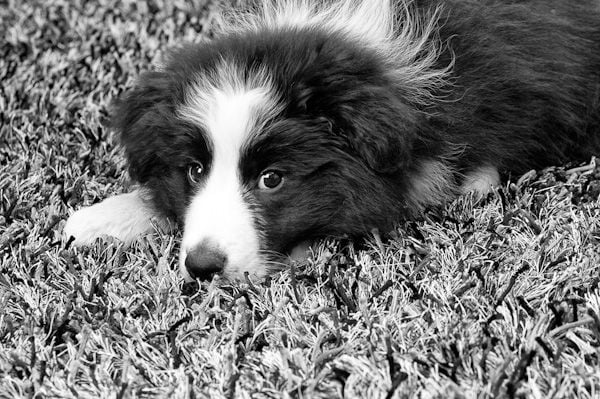)
One of the first considerations when you bring home a new puppy is setting up a regular toileting routine. Every puppy is different in how long they take to learn and that’s a combination of their individual personalities and their early experiences with the breeder.
They develop a preference for going on a particular surface, so I will assume that most people want that to be grass, but if it’s different for you just replace “grass” in this blog with “your chosen surface” (eg could be pebbles/gravel). If your puppy has come from a breeder where the pups had the chance to move away from their sleeping/eating/playing area to go to the toilet on grass that may well speed up the learning process with you. If on the other hand they’ve been raised in a concrete pen that may make the learning process a bit slower.
Puppies are most likely to need to go to the toilet if they:
Most, but not all pups will give you some signal they need to go; sniffing, circling, whining, looking restless, stopping playing with a toy, wandering off, going to the door they normally go out through. Learn to read your pup’s signals so that you can quickly take them outside when you see them tell you they need to go. If you have a puppy who gives little or no signals, you will need to be extra vigilant.
The frequency of toilet breaks will depend on your pup’s age and size (younger/smaller generally need to go more often), and activity level; just like humans they can hang on longer when they are asleep, but if they are racing around doing lots of active things they will need to go more often. And again, each puppy will have different abilities to hold on, so take this into account too.
If for example you think your pup needs to go every hour, take them outside to the grassed area you want them to use every 45 minutes. Be low key, don’t try and engage them in any play or training, in fact some dogs prefer you to look away! Just be outside with them to observe, if they do go to the toilet, quietly praise them, you can reward them with a treat if you want to. Once they are empty, they can now come back inside.
If you go out for a toilet break, just keep it brief, if after 5 minutes for example they haven’t been, bring them back inside but this time, keep them on a lead or behind a child gate/playpen etc and try again a short time later. This way they won’t wander off and go somewhere in the house when you aren't watching.
Try to make sure everyone in the house is being consistent, and know who is responsible for taking the pup out to the toilet. If you need to have a roster system, put a list up on the fridge of who does which shift!
At night time if your pup can’t yet last through, someone will need to get up during the night to take them out or they will need to be in an area where they can comfortably move away from their sleeping area to relieve themselves. Puppy pads can be used in this situation or at any time when they can’t access a toileting area, however I recommend these are phased out as quickly as possible and not all pups use them for the intended purpose, often they are just shredded instead!
There isn’t a set time frame for pups to become toilet trained as there are so many factors that influence this. By 4 months old I’d expect there to be consistent improvements, some pups may well be toilet trained by this age, but if there are still accidents they need to be happening less often. By 6 months, if there’s the occasional accident I wouldn’t be too concerned as long as it’s infrequent. If however by 6 months you aren’t making progress then getting further help and advice from a qualified trainer would be recommended.
Hopefully it’s common knowledge now that you never punish a puppy for toileting in the house, the likely outcome of doing this is your pup will be too scared to go in front of you and that’s the last thing you need. And just for the record puppies don’t pee on the carpet to get back at you because you left them alone for 3 hours (just in case anyone thinks that’s a “thing”).
Whilst this information is written specifically for puppies, the same principles apply for older dogs, just they can likely hang on for longer. If however your adult dog who is toilet trained suddenly starts having accidents in the house, it’s time for a vet visit to rule out any physical problems.
Of course there are some pups who don't read the rule books, and there are additional things that can occur to complicate the toilet training process, but the information here works well for most puppies, most of the time!
| Tags:Puppy Training |